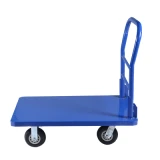Benefits of Using a Trolley
2024-06-07
Trolleys offer several benefits for transporting goods and materials in commercial, industrial, and institutional settings. Here are some of the key benefits of using a trolley:
1. Efficient Material Handling: Trolleys provide an efficient means of transporting goods, equipment, and materials from one location to another. They can carry multiple items simultaneously, reducing the need for manual handling and minimizing the risk of injuries associated with lifting and carrying heavy loads.
2. Increased Productivity: Trolleys help streamline material handling processes, allowing workers to move items more quickly and efficiently. This increased productivity can lead to time savings and improved workflow in warehouses, manufacturing facilities, retail stores, and other workplaces.
3. Versatility: Trolleys come in various sizes, designs, and configurations to accommodate different types of loads and environments. They can be customized with shelves, bins, drawers, and other features to suit specific transportation needs and storage requirements.
4. Ease of Use: Trolleys are designed for ease of use, with ergonomic handles, smooth-rolling wheels, and maneuverable designs that make them easy to push, pull, and steer. This user-friendly design minimizes operator fatigue and ensures comfortable handling during transportation tasks.
5. Space Optimization: Trolleys help optimize space utilization by providing organized storage and transportation solutions for goods and materials. They can be used to consolidate items, reduce clutter, and maximize available floor space in warehouses, storerooms, and other storage areas.
6. Improved Safety: Trolleys contribute to a safer working environment by reducing the risk of manual handling injuries, strains, and accidents. By providing a stable platform for transporting loads, trolleys help prevent trips, falls, and other workplace hazards associated with carrying heavy or awkward items.
7. Cost Savings: Trolleys offer cost savings by improving efficiency, reducing labor costs, and minimizing the risk of damage to goods during transportation. Investing in durable, high-quality trolleys can lead to long-term savings by reducing the need for repairs and replacements over time.
8. Enhanced Organization: Trolleys help maintain order and organization in workplaces by providing designated storage and transportation solutions for items such as tools, supplies, inventory, and equipment. This organization can improve inventory management, inventory control, and overall workplace efficiency.
9. Flexibility: Trolleys are highly flexible and adaptable to different environments and applications. They can be used indoors or outdoors, on flat surfaces or uneven terrain, and in various industries such as manufacturing, distribution, hospitality, healthcare, and retail.
Overall, trolleys are versatile, efficient, and practical tools for transporting goods and materials in a wide range of settings. Their benefits include increased productivity, improved safety, space optimization, and cost savings, making them indispensable assets for businesses, organizations, and institutions seeking to streamline material handling processes and enhance operational efficiency.



